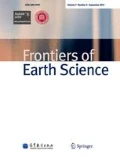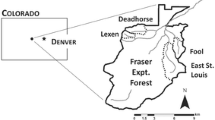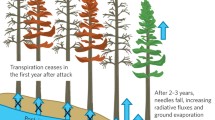Abstract
Natural or human-influenced disturbances are important to the health and diversity of forests, which in turn, are important to the water quantity and quality exported from a catchment. However, human-induced disturbances (prescribed fire and harvesting) have been decreasing, and natural disturbances (fires and insects) have been increasing in frequency and severity. One such natural disturbance is the mountain pine beetle (MPB), (Dendroctonus ponderosae) an endemic species. A recent epidemic resulted in the mortality of millions of hectares of lodgepole pine (Pinus contorta) forests in Colorado, USA. Beetle-induced tree mortality brings about changes to the hydrologic cycle, including decreased transpiration and interception with the loss of canopy cover. This study examined the effect of the mountain pine beetle kill on source water contributions to streamflow in snowmeltdominated headwater catchments using stable isotopes (2H and 18O) as tracers. Study catchments with varying level of beetle-killed forest area (6% to 97%) were sampled for groundwater, surface water, and precipitation. Streams were sampled to assess whether beetle-killed forests have altered source water contributions to streamflow. Groundwater contributions increased with increasing beetle-killed forest area (p = 0.008). Both rain and snow contributions were negatively correlated with beetle-killed forest area (p = 0.035 and p = 0.011, respectively). As the beetle-killed forest area increases, so does fractional groundwater contribution to streamflow.
Similar content being viewed by others
References
Alpert P (1986). Mesoscale indexing of the distribution of orographic precipitation over high mountains. J Appl Meteorol Climatol, 25(4): 532–545
Baker W L, Veblen T T (1990). Spruce beetles and fires in the nineteenth-century subalpine forests of Western Colorado, U.S.A. Arct Alp Res, 22(1): 65–80
Bearup L A, Maxwell R M, Clow D W, McCray J E (2014). Hydrological effects of forest transpiration loss in bark beetleimpacted watersheds. Nat Clim Chang, 4(6): 481–486
Bentz B J, Regniere J, Fettig C J, Hansen E M, Hayes J L, Hicke J A, Kelsey R G, Negron J F, Seybold S J (2010). Climate change and bark beetles of the western United States and Canada: direct and indirect effects. Bioscience, 60(8): 602–613
Bergen J D (1971). Vertical profiles of wind speed in a pine stand. For Sci, 17(3): 314–321
Bethlahmy N (1974). More streamflow after a bark beetle epidemic. J Hydrol (Amst), 23(3–4): 185–189
Bethlahmy N (1975). A Colorado episode: beetle epidemic, ghost forests, more streamflow. Northwest Sci, 49(2): 95–105
Biederman J A, Brooks P D, Harpold A A, Gochis D J, Gutmann E, Reed D E, Pendall E, Ewers B E (2014a). Multiscale observations of snow accumulation and peak snowpack following widespread, insectinduced lodgepole pine mortality. Ecohydrology, 7(1): 150–162
Biederman J A, Harpold A A, Gochis D J, Ewers B E, Reed D E, Papuga S A, Brooks P D (2014b). Increased evaporation following widespread tree mortality limits streamflow response. Water Resour Res, 50(7): 5395–5409
Biederman J A, Somor A J, Harpold A A, Gutmann E D, Breshears D D, Troch P A, Gochis D J, Scott R L, Meddens A J H, Brooks P D (2015). Recent tree die-off has little effect on streamflow in contrast to expected increases from historical studies. Water Resour Res, 51(12): 9775–9789
Boon S (2007). Snow accumulation and ablation in a beetle-killed pine stand in Northern Interior British Columbia. BC J Ecosyst Manag, 8(3): 1–13
Boon S (2009). Snow ablation energy balance in a dead forest stand. Hydrological Processes, 23(18): 2600–2610
Boon S (2012). Snow accumulation following forest disturbance. Ecohydrology, 5(3): 279–285
British Columbia Ministry of Forests (1995). Bark beetle management guidebook. Forest practices code. Victoria, BC. Forest Practices Branch. Available from: http://www.for.gov.bc.ca/tasb/legsregs/fpc/fpcguide/beetle/betletoc.htm Accessed 08 Nov 2011
Carpenter S R, Mooney H A, Agard J, Capistrano D, DeFries R S, Diaz S, Dietz T, Duraiappah A K, Oteng-Yeboah A, Pereira H M, Perrings C, Reid W V, Sarukhan J, Scholes R J, Whyte A (2009). Science for managing ecosystem services: beyond the Millennium Ecosystem Assessment. Proc Natl Acad Sci USA, 106(5): 1305–1312
Chen F, Zhang G, Barlage M, Zhang Y, Hicke J A, Meddens A, Zhou G, Massman W J, Frank J (2015). An observational and modeling study of impacts of bark beetle-caused tree mortality on surface energy and hydrological cycles. J Hydrometeorol, 16(2): 744–761
Cheng J D (1989). Streamflow changes after clear-cut logging of a pine beetle-infested watershed in southern British Columbia, Canada. Water Resour Res, 25(3): 449–456
Clow D W, Rhoades C, Briggs J, Caldwell M, Lewis W M Jr (2011). Responses of soil and water chemistry to mountain pine beetle induced tree mortality in Grand County, Colorado, USA. Appl Geochem, 26: S174–S178
Colorado Water Conservation Board (CWCB) (2010). Colorado’s Water Supply Future: State of Colorado 2050 Municipal and Industrial Water Use Projections. Available from: http://cospl.coalliance.org/fedora/repository/co:9366/nr32f982010internet.pdf
Eisenhart K, Veblen T T (2000). Dendrochronological detection of spruce bark beetle outbreaks in northwestern Colorado. Can J Res, 30(11): 1788–1798
Fassnacht S R, Dressler K A, Bales R C (2003). Snow water equivalent interpolation for the Colorado River Basin from snow telemetry (SNOTEL) data. Water Resour Res, 39(8), doi: 10.1029/2002WR001512
Feng X, Taylor S, Renchaw C E, Kirchner J W (2002). Isotopic evolution of snowmelt 1. A physically based one-dimensional model. Water Resour Res, 38(10): 1–8
Fettig C J, Klepzig K D, Billings R F, Munson S A, Nebeker T E, Negron J F, Nowak J T (2007). The effectiveness of vegetation management practices for prevention and control of bark beetle infestations in coniferous forests of the western and southern United States. For Ecol Manage, 238(1–3): 24–53
Gat J R (2010). Isotope Hydrology: A Study of the Water Cycle. Series on Environmental Science and Management, 1–69
Hazlett S, Hansen N (2007). Current status of the mountain pine beetle in the west—A literature review. USDA Forest Service, P.A.09.2009. Washington, D.C. 1–4
Hermann A, Stichler W (1981). Isotope input into runoff systems from melting snow covers. Nord Hydrol, 12: 309–318
Ingraham N L (1998). Isotopic Variations in Precipitaiton. In: Kendall C, McDonnell J J, eds. Isotope Tracers in Catchment Hydrology. Amsterdam: Elsevier Science B.V., 87–118
International Atomic Energy Agency (IAEA) (1997). Technical procedure for cumulative monthly sampling of precipitation for isotopic analysis. Available from: http://www-naweb.iaea.org/NAALIHL/docs/tech_info/Precipitation%20Sampling97.pdf. Accessed 16 October 2015
Leatherman D A (2008). The Health of Colorado’s Forests: High Elevation Forests. Edited by Colorado Department of Natural Resources. Colorado State University, Fort Collins, CO. p. 17
Livneh B, Deems J S, Buma B, Barsuguli J J, Schneider D, Molotch N P, Wolter K, Wessman C A (2015). Catchment response to bark beetle outbreak and dust-on-snow in the Colorado Rocky Mountains. J Hydrol (Amst), 523: 196–210
Love L D (1955). The effects on stream flow of the killing of spruce and pine by the Engelmann Spruce beetle. Trans Am Geophys Union, 36(1): 113–118
Maggart A (2014). Effects of mountain pine beetle caused tree mortality on streamflow generation mechanism in Colorado. MS Thesis Catchment Science, Colorado State University, Fort Collins, CO
Man G (2012). Major Forest Insect and Disease Conditions in the United States: 2011. USDA Forest Service, Report No: FS-1000
Maxwell J (2009). Forest headwaters-saving our water source. USDA Forest Service Regional Office Denver, CO. Unpublished memo.6pp
Menger A L (2015). Response of streamflow and stream chemistry to pine beetle induced tree mortality across northern Colorado. MS Thesis Watershed Science, Colorado State University. Fort Collins, CO
Mikkelson K M, Bearup L A, Maxwell R M, Stednick J D, McCray J E, Sharp J O (2013a). Bark beetle infestation impacts on nutrient cycling, water quality, and interdependent hydrological effects. Biogeochemistry, 115(1–3): 1–21
Mikkelson K M, Maxwell R M, Ferguson I, Stednick J D, McCray J E, Sharp J O (2013b). Mountain pine beetle infestation impacts: modeling water and energy budgets at the hill-slope scale. Ecohydrology, 6(1): 64–72
Morris J L, Cottrell S, Fettig C J, Hansen WD, Sherriff R L, Carter V A, Clear J L, Clement J, DeRose R J, Hicke J A, Higuera P E, Mattor K M, Seddon A W R, Sepp H T, Stednick J D, Seybold S J (2016). Managing bark beetle impacts on social-ecological systems: priority questions to inspire future research. J Appl Ecol, doi: 10.1111/1365-2664.12782
Parnell A, Jackson A (2015). SIAR: Stable Isotope Analysis in R (Version 4.2). [Software]. Available at http://cran.r-project.org/web/packages/siar/index.html
Potts D F (1984). Hydrologic impacts of a large-scale mountain pine beetle (Dendroctonus ponderosae) epidemic. Water Resour Bull, 20(3): 373–377
Pugh E, Gordon E (2013). A conceptual model of water yield impacts from beetle-induced tree death in snow-dominated lodgepole pine forests. Hydrol Processes, 27(14): 2048–2060
Pugh E, Small E (2012). The impact of pine beetle infestation on snow accumulation and melt in the headwaters of the Colorado River. Ecohydrology, 5(4): 467–477
Raffa K F, Aukema B H, Bentz B J, Carroll A L, Hicke J A, TurnerMG, Romme W H (2008). Cross-scale drivers of natural disturbances prone to anthropogenic amplification: the dynamics of bark beetle eruptions. Bioscience, 58(6): 501–517
Rhoades C C, McCutchan J H, Cooper L A, Clow D, Detmer T M, Briggs J S, Stednick J D, Veblen T T, Ertz RM, Likens G E, LewisW M (2013). Biogeochemistry of beetle-killed forests: explaining a weak nitrate response. Proc Natl Acad Sci USA, 110(5): 1756–1760
Seidl R, Schelhaas M J, Lexer M J (2011). Unraveling the drivers of intensifying forest disturbance regimes in Europe. Glob Change Biol, 17(9): 2842–2852
Spittlehouse D (2007). Influence of the mountain pine beetle on the site water balance of lodgepole pine forests. In: Proceedings Mountain Pine Beetle and Catchment Hydrology Workshop: Preliminary Results of Research from BC, Alberta and Colorado. 25–26
Stednick J D (1996). Monitoring the effects of timber harvest on annual water yields. J Hydrol (Amst), 176(1–4): 79–95
Stednick J D, Troendle C A (2016). Chapter 12. Hydrologic effects of forest management practices on water resources. In: Forest Hydrology: Processes, Management, and Assessment. CABI Publishing, 192–203
Taylor S, Feng X, Renshaw C, Kirchner E (2001). Isotopic evolution of snowmelt: validation and parameterization of a one-dimensional model using controlled snowmelt experiments. Water Resour Res, 37: 759–769
Taylor S, Feng X, Williams M, McNamara J (2002). How isotopic fractionation ofsnowmelt affects hydrograph separation. Hydrol Processes, 16(18): 3683–3690
Teti P (2007). Solar Radiation and Snow Ablation in Natural and Managed Pine Stands. In: Proceedings Mountain Pine Beetle and Catchment Hydrology Workshop: Preliminary Results of Research from BC, Alberta and Colorado. 17–18
Thomson A J, Shrimpton D M (1984). Weather associated with the start of mountain pine-beetle outbreaks. Can J Res, 14(2): 255–258
USDA (2014). Aerial Detection Survey [Data file]. Retrieved from http://www.fs.usda.gov/detail/r2/forest-grasslandhealth/?cid =fsbdev3_041629
USGS Land Cover Institute (2005). Conifer Forest Layer [Data file] Retrieved from http://landcover.usgs.gov/nalcms.php
USGS National Elevation Dataset (2013). The National Map [Data file] Retrieved from http://nationalmap.gov/elevation.html
Veblen T T, Hadley K S, Nel E M, Kitzberger T, Reid M, Villalba R (1994). Disturbance regime and disturbance interactions in a Rocky Mountain subalpine forest. J Ecol, 82(1): 125–135
Weed A S, Ayres M P, Hicke J A (2013). Consequences of climate change for biotic disturbances in North American forests. Ecol Monogr, 83(4): 441–470
Wehner C E (2016). Effect of mountain pine beetle kill on streamflow generation mechanisms. MS Thesis Watershed Science, Colorado State University. Fort Collins, CO
Winkler R D (2007). Snow accumulation and melt in southern interior lodgepole pine forests. In: Proceedings Mountain Pine Beetle and Catchment Hydrology Workshop: Preliminary Results of Research from BC, Alberta and Colorado. 19–20
Acknowledgements
Support for this project was made available by the National Science Foundation grant 1204460: Water Quality and Supply Impacts from Climate-Induced Insect Tree Mortality. The work expands upon work done by Ariann Maggart and Ashley Menger. The authors also acknowledge the useful comments provided by the anonymous reviewers.
Author information
Authors and Affiliations
Corresponding author
Rights and permissions
About this article
Cite this article
Wehner, C.E., Stednick, J.D. Effects of mountain pine beetle-killed forests on source water contributions to streamflow in headwater streams of the Colorado Rocky Mountains. Front. Earth Sci. 11, 496–504 (2017). https://doi.org/10.1007/s11707-017-0660-1
Received:
Accepted:
Published:
Issue Date:
DOI: https://doi.org/10.1007/s11707-017-0660-1




